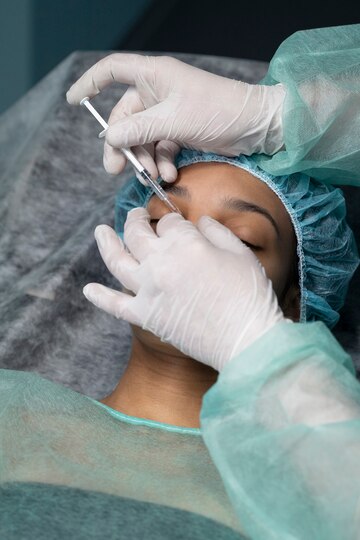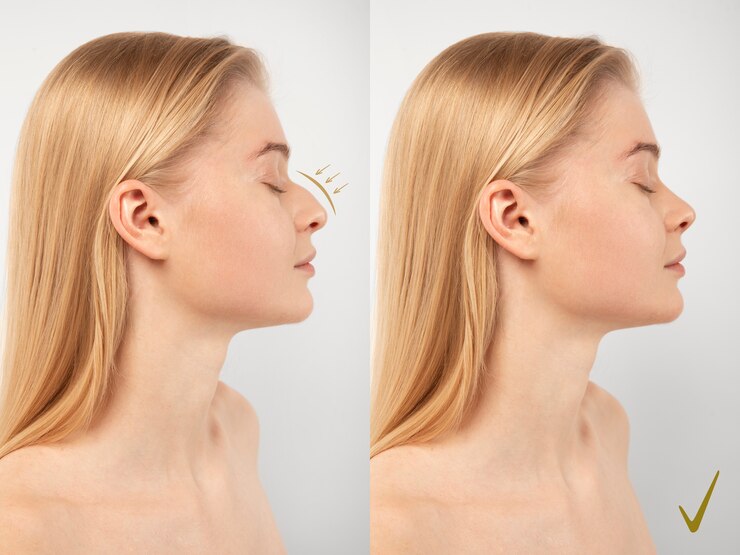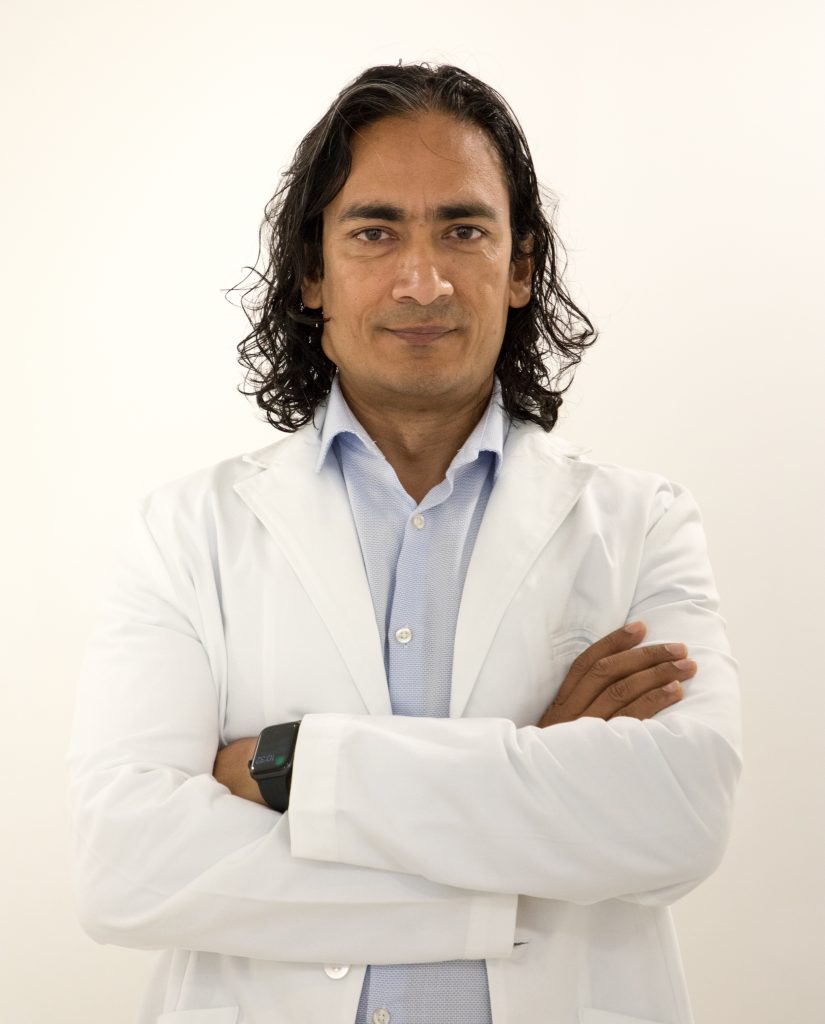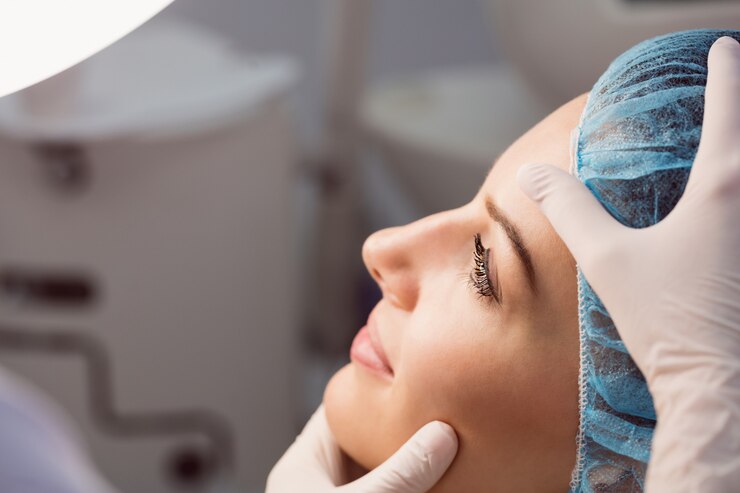Surgical Nose Job
Whether refining shape or improving breathing, rhinoplasty offers permanent, life-changing results.
What is Surgical
Nose Job?
Surgical rhinoplasty, commonly referred to as a “nose job,” is a procedure that modifies the shape, size, or proportions of the nose. This surgery can address various concerns, including:
Cosmetic Enhancements: Adjusting the size of the nose, reshaping the tip, removing bumps, or altering the angle between the nose and the upper lip.
Functional Corrections: Improving breathing difficulties caused by structural issues like a deviated septum.
The procedure involves making incisions to access the bones and cartilage that support the nose. Depending on the desired outcome, some bone or cartilage may be removed, or tissue may be added. The skin and tissue are then redraped over the nasal structure, and incisions are closed.

What is Surgical Nose Job?

Surgical rhinoplasty, commonly referred to as a “nose job,” is a procedure that modifies the shape, size, or proportions of the nose. This surgery can address various concerns, including:
Cosmetic Enhancements: Adjusting the size of the nose, reshaping the tip, removing bumps, or altering the angle between the nose and the upper lip.
Functional Corrections: Improving breathing difficulties caused by structural issues like a deviated septum.
The procedure involves making incisions to access the bones and cartilage that support the nose. Depending on the desired outcome, some bone or cartilage may be removed, or tissue may be added. The skin and tissue are then redraped over the nasal structure, and incisions are closed.

Open vs. Closed Rhinoplasty
There are two primary approaches to surgical rhinoplasty:
Open Rhinoplasty: Involves a small incision on the columella (the tissue between the nostrils), allowing the surgeon to lift the skin off the tip of the nose and have a clear view of the nasal structures. This approach is often preferred for more complex surgeries.
Closed Rhinoplasty: All incisions are made within the nostrils, resulting in no visible scarring. This method is typically used for less extensive reshaping.
Open vs. Closed Rhinoplasty

There are two primary approaches to surgical rhinoplasty:
Open Rhinoplasty: Involves a small incision on the columella (the tissue between the nostrils), allowing the surgeon to lift the skin off the tip of the nose and have a clear view of the nasal structures. This approach is often preferred for more complex surgeries.
Closed Rhinoplasty: All incisions are made within the nostrils, resulting in no visible scarring. This method is typically used for less extensive reshaping.
Who’s the Ideal Candidate?
Yes if:
✅ You’re physically healthy and a non-smoker.
✅ Your nose growth has plateaued (usually by age 15–16 for girls, 17–18 for boys).
✅ You have realistic expectations (no, you won’t look like Zendaya).
No if:
❌ You’re seeking perfection or using surgery to “fix” your life.
❌ You have uncontrolled health issues (e.g., bleeding disorders).
❌ You’re pregnant or breastfeeding.

Who’s the Ideal Candidate?

Yes if:
✅ You’re physically healthy and a non-smoker.
✅ Your nose growth has plateaued (usually by age 15–16 for girls, 17–18 for boys).
✅ You have realistic expectations (no, you won’t look like Zendaya).
No if:
❌ You’re seeking perfection or using surgery to “fix” your life.
❌ You have uncontrolled health issues (e.g., bleeding disorders).
❌ You’re pregnant or breastfeeding.
Benefits Of Surgical Nose Job
Enhance your nose’s shape with a quick, surgical nose job for natural, permanent results.
Permanent Results
Unlike non-surgical alternatives, surgical rhinoplasty offers lasting changes.
Comprehensive Reshaping
Allows for significant alterations to both the form and function of the nose.
Improved Breathing
Can correct structural issues that impede airflow, enhancing respiratory function.
Customization
Surgeons can sculpt bone, cartilage, and soft tissue to match your facial harmony.
Potential Risks and Considerations
As with any major surgery, rhinoplasty carries certain risks, including:
Anesthesia Complications
Adverse reactions to anesthesia.
Infection
Though rare, infections can occur post-surgery.
Bleeding
Some bleeding is typical, but excessive bleeding may require medical attention.
Scarring
Especially with open rhinoplasty, though scars are usually minimal and well-concealed.






The Process, Step by Step
Here’s what to expect when you choose us for your nose transformation.
Consultation
Your surgeon assesses your nose’s structure, discusses goals, and uses imaging software to simulate results.
Pro tip: Bring photos of noses you love and hate.
Preparation
Stop smoking, avoid blood thinners (ibuprofen, aspirin), and arrange post-op help.
Surgery Day
Under general anesthesia or IV sedation, the surgeon reshapes bone/cartilage via open or closed method. Surgery lasts 1.5–3 hour
Recovery
Week 1: Splint + nasal packing (if needed), face swelling peaks, pain managed with meds.
Week 2: Splint removed! Swelling/bruising fades by 50%.
Month 6–12: Residual swelling (especially the tip) disappears. Final shape emerges.

The Reason Why People Trust Our Doctors
At Cosmetic Surgery Centre, trust is built on board-certified expertise, uncompromising safety, and a passion for natural, patient-first results. Our London-based surgeons combine 15+ years of specialized rhinoplasty experience with cutting-edge techniques—from ultrasonic bone sculpting to precision suture lifts—all performed in CQC-accredited facilities.
But what truly sets us apart?
We listen.
Every treatment plan is tailored to your unique anatomy and goals, backed by transparent consultations, CE/FDA-approved materials, and 24/7 aftercare.
No pushy sales pitches, no shortcuts—just ethical care that’s earned us glowing reviews and lifelong patient relationships.
Ready to Meet Your Surgeon?
Book a free consultation and experience firsthand why patients say, “I finally found doctors who listen.”
The Reason Why People Trust Our Doctors

At Cosmetic Surgery Centre, trust is built on board-certified expertise, uncompromising safety, and a passion for natural, patient-first results. Our London-based surgeons combine 15+ years of specialized rhinoplasty experience with cutting-edge techniques—from ultrasonic bone sculpting to precision suture lifts—all performed in CQC-accredited facilities.
But what truly sets us apart?
We listen.
Every treatment plan is tailored to your unique anatomy and goals, backed by transparent consultations, CE/FDA-approved materials, and 24/7 aftercare.
No pushy sales pitches, no shortcuts—just ethical care that’s earned us glowing reviews and lifelong patient relationships.
Ready to Meet Your Surgeon?
Book a free consultation and experience firsthand why patients say, “I finally found doctors who listen.”
Enjoy expert nose reshaping at a special discount! Whether it’s a Liquid Nose Job, Filler, Suture Lift, or Rhinoplasty, book now and save on your first treatment.
Reviews From Recent Clients
Don’t just take our word for it—hear from real people who’ve transformed their noses (and lives) with us. From surgical breakthroughs to subtle non-surgical tweaks, our clients share their honest journeys.
“I wasn’t ready for surgery, but I wanted to smooth out a small bump on my nose. The non-surgical option was perfect! The filler took 20 minutes, and the results looked so natural. My friends just said I looked ‘well-rested’—no one guessed I’d had work done. Highly recommend for subtle tweaks!”
“I loved the idea of a thread lift—minimal downtime but more lasting than fillers. The suture lift lifted my drooping nasal tip beautifully, and the recovery was a breeze. It’s been a year, and my nose still looks refined. The team at [Your Clinic Name] truly listens to what you want!”
Frequently Asked Questions
Everything you need to know about nose surgery, from procedures and recovery to costs and consultations.
What is the difference between open and closed rhinoplasty?
In open rhinoplasty, a small incision is made on the columella (the tissue between the nostrils), allowing the surgeon to lift the skin and have a clear view of the nasal structures. Closed rhinoplasty involves incisions made within the nostrils, resulting in no visible external scars. The choice between the two depends on the complexity of the surgery and the surgeon’s approach.
How should I prepare for nose surgery?
Preparation steps include:
- Undergoing a medical evaluation.
- Avoiding certain medications that increase bleeding risk.
- Stopping smoking to promote better healing.
- Arranging for someone to drive you home post-surgery and assist you during the initial recovery period.
What can I expect on the day of surgery?
On the day of surgery:
- You’ll receive anesthesia for comfort.
- The procedure typically lasts between 1 to 3 hours, depending on complexity.
- Post-surgery, you’ll be monitored in a recovery area before being discharged. Rhinoplasty is usually an outpatient procedure, so an overnight stay is generally not needed.
How long does a rhinoplasty procedure take?
The duration of the surgery varies based on the specific corrections needed but generally ranges from 1 to 3 hours.
Will I have visible scars after rhinoplasty?
In closed rhinoplasty, incisions are inside the nostrils, leaving no visible scars. Open rhinoplasty involves a small incision on the columella, which typically heals well and becomes minimally noticeable over time.
How long after rhinoplasty can I wear glasses?
It’s advisable to avoid resting glasses on your nose for a few weeks post-surgery to prevent pressure on the healing nasal structures. Options include using special supports or taping glasses to your forehead during this period.
When can I see the final results of my rhinoplasty?
While initial improvements are noticeable after the splint is removed, the final shape of your nose may take up to a year to fully refine as residual swelling subsides.

